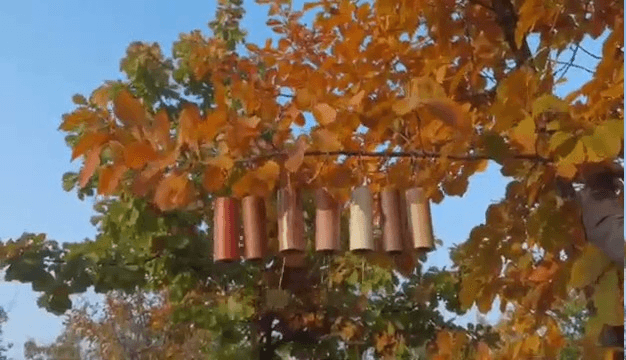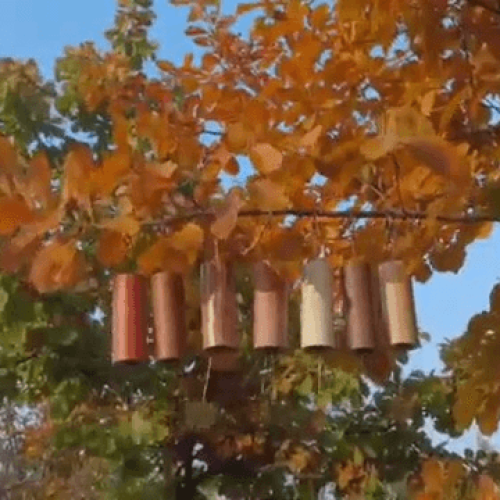Bamboo wind chimes represent one of nature’s most harmonious musical instruments, combining the organic beauty of bamboo with the gentle power of wind to create soothing soundscapes that enhance any environment. These remarkable instruments embody the perfect fusion of functionality and natural aesthetics, offering sustainable alternatives to metal wind chimes while producing uniquely warm, mellow tones that complement both indoor and outdoor settings with their gentle, organic resonance.
Unlike synthetic materials that create harsh or artificial sounds, bamboo provides naturally dampened tones with rich harmonic content that blends seamlessly with environmental sounds. The hollow structure of bamboo tubes creates natural resonating chambers that amplify and enrich the fundamental tones while the organic fiber composition filters out harsh frequencies, resulting in pure, pleasing sounds that promote relaxation and tranquility.
The environmental sustainability of bamboo makes these wind chimes particularly appealing to environmentally conscious consumers who seek beautiful, functional products that support ecological responsibility. Bamboo’s rapid growth rate and renewable nature ensure minimal environmental impact while providing materials with exceptional acoustic properties that create lasting musical instruments of remarkable beauty and functionality.

Construction Design and Product Classification
Basic Structural Components
The bamboo tube system forms the heart of every wind chime, with individual tubes carefully selected and prepared to produce specific pitches and tonal qualities. Each tube’s length primarily determines its fundamental frequency, while diameter and wall thickness influence tonal character and acoustic projection. The natural variation in bamboo growth creates subtle differences between tubes that add organic complexity to the overall sound palette.
Tube preparation involves careful selection of bamboo segments with appropriate dimensions and acoustic properties for the intended musical scale. The natural nodes within bamboo stems provide optimal cutting points that maximize resonance while maintaining structural integrity. Open-ended tubes generally produce brighter, more projective tones, while tubes with one closed end create deeper, more mellow sounds with enhanced bass response.
The suspension system requires careful engineering to ensure proper tube spacing, optimal wind capture, and balanced acoustic response. The top suspension plate distributes weight evenly while providing multiple attachment points for individual tubes. String or cord selection affects both durability and acoustic transmission, with natural fibers often preferred for their organic appearance and environmental compatibility.
The central striker mechanism serves as the primary sound activation device, requiring careful positioning and weight distribution to ensure consistent contact with surrounding tubes. The striker’s material composition significantly influences the attack characteristics and tonal quality of each strike. Bamboo strikers create gentle, organic attack sounds, while wooden strikers provide more defined percussive characteristics.
Suspension cord materials range from natural fibers like cotton or hemp to synthetic materials offering enhanced weather resistance and longevity. The cord attachment method affects both security and acoustic transmission, with secure knots preventing unwanted movement while allowing optimal vibration transfer. Adjustable suspension systems enable fine-tuning of tube spacing and striker positioning for optimal acoustic performance.
Bamboo Material Types and Characteristics
Natural bamboo varieties offer distinct acoustic and aesthetic characteristics that influence the final instrument’s sound and appearance. Moso bamboo provides excellent acoustic properties with straight grain and consistent wall thickness that produces clear, resonant tones. The natural golden color develops beautifully over time, creating warm visual appeal that complements various decorative schemes.
Green bamboo offers vibrant natural coloration with slightly brighter acoustic characteristics compared to mature golden bamboo. The higher moisture content in fresh bamboo creates unique tonal qualities that evolve as the material continues drying, providing dynamic sound characteristics that change subtly over the instrument’s early life. However, green bamboo requires careful drying to prevent cracking and dimensional instability.
Black bamboo creates sophisticated visual appeal with deeper, more mellow tonal characteristics compared to lighter varieties. The darker pigmentation often correlates with denser material composition that produces enhanced bass response and longer sustain times. Black bamboo wind chimes provide elegant aesthetic appeal while generating rich, warm tones that complement contemplative environments.
Yellow bamboo offers bright visual characteristics with balanced acoustic properties that work well for general-purpose applications. The natural golden coloration provides cheerful visual appeal while the acoustic properties offer good balance between brightness and warmth. Yellow bamboo varieties often provide excellent durability and weather resistance for outdoor applications.
Processing treatments significantly affect both appearance and acoustic properties of bamboo materials. Natural air-drying preserves the organic character while ensuring dimensional stability and optimal acoustic properties. Heat treatment can accelerate drying while creating darker colors and enhanced weather resistance. Chemical treatments may improve pest resistance and longevity but can affect natural acoustic properties.
Size Classifications and Tonal Ranges
Small decorative wind chimes measuring 6-12 inches in overall length provide compact installations suitable for indoor use or intimate outdoor spaces. These instruments typically produce higher frequency ranges with bright, cheerful tones that add gentle musical accents without overwhelming smaller environments. The reduced size makes them ideal for apartments, small patios, or desktop installations where space considerations limit larger instruments.
The compact design enables easy relocation and seasonal storage while providing sufficient acoustic output for personal enjoyment and close-proximity applications. Small bamboo wind chimes often feature simplified tube arrangements with fewer elements, making them cost-effective entry points for those new to wind chime appreciation. Despite their modest size, quality small instruments can produce remarkably rich and satisfying sound palettes.
Medium-sized wind chimes ranging from 12-24 inches offer balanced acoustic performance suitable for most residential applications. This size category provides optimal compromise between acoustic power and practical convenience, generating sufficient volume for outdoor enjoyment while remaining manageable for indoor installations. The expanded tube count enables more complex musical arrangements with richer harmonic content.
Medium wind chimes typically incorporate 5-8 tubes arranged in musical scales that create pleasing harmonic relationships when activated by wind currents. The increased resonating volume produces more sustained tones with enhanced projection that fills medium-sized spaces effectively. This size category represents the most popular choice for general residential use due to its versatile performance characteristics.
Large garden wind chimes exceeding 24 inches in length create impressive acoustic displays suitable for spacious outdoor environments. These substantial instruments produce powerful low-frequency content with extended sustain times that carry across large distances. The increased tube count and dimensions enable complex musical arrangements with sophisticated harmonic relationships that create rich acoustic environments.
Professional-grade large wind chimes often incorporate 8-12 or more tubes arranged in complete musical scales or sophisticated chord progressions. The substantial construction requires robust suspension systems capable of supporting increased weight while maintaining proper acoustic positioning. Large instruments provide impressive visual impact while generating room-filling sound that transforms outdoor spaces into musical environments.
Hanging Installation and Usage Tips
Location Selection Principles
Indoor hanging applications require careful consideration of ceiling structure, room acoustics, and practical accessibility for maintenance and seasonal adjustments. Structural mounting points must provide adequate load-bearing capacity for the wind chime’s weight plus dynamic forces from movement and air currents. Standard ceiling hooks may prove inadequate for larger instruments, requiring substantial mounting hardware for safety and stability.
Room acoustics significantly influence the perceived sound quality and volume of indoor wind chimes. Hard surfaces like tile, hardwood, or plaster create reflective environments that enhance acoustic projection while carpeted rooms with soft furnishings provide more absorptive environments that create intimate sound experiences. The positioning relative to walls and corners affects acoustic reinforcement and tonal balance.
Air circulation becomes crucial for indoor installations since natural wind currents may be minimal or non-existent. Positioning near heating vents, air conditioning outlets, or frequently opened doors provides natural air movement that activates the wind chime. Ceiling fans can create gentle air currents, though care must be taken to prevent excessive movement that could damage the instrument.
Outdoor hanging locations require evaluation of wind exposure, weather protection, and environmental factors that affect both sound production and instrument longevity. Optimal wind exposure provides consistent but not excessive air movement that activates the chimes regularly without creating violent motion that could cause damage. Protected locations under eaves or pergolas offer weather protection while maintaining wind access.
The surrounding acoustic environment influences the wind chime’s effectiveness and appropriateness. Rural locations with minimal background noise allow subtle wind chime sounds to be appreciated fully, while urban environments may require larger, more powerful instruments to overcome ambient noise. Consideration of neighbors and local noise ordinances ensures that wind chime installations remain welcome additions to the community.
Installation Methods and Techniques
Suspension hardware selection affects both safety and acoustic performance, requiring components rated for the wind chime’s static weight plus dynamic loading from wind forces. Swivel connections prevent tangling while allowing natural rotation that ensures even wind exposure from all directions. Quality swivel hardware maintains smooth operation while providing secure connections that prevent accidental release.
Height adjustment affects both acoustic performance and practical considerations like maintenance access and visual appeal. Higher installations generally receive better wind exposure while creating wider sound distribution patterns. However, excessive height may place instruments beyond practical reach for maintenance while potentially exposing them to stronger wind forces that could cause damage.
Leveling and spacing adjustments ensure optimal acoustic performance and visual symmetry. Proper leveling prevents binding or uneven tube contact while ensuring that the striker maintains proper positioning relative to surrounding tubes. Spacing adjustments affect the probability and intensity of tube contacts while influencing the overall acoustic character of the instrument.
The installation process requires systematic steps to ensure safety and optimal performance. Initial mounting point preparation includes structural assessment and hardware installation using appropriate fasteners for the mounting surface material. The hanging process requires careful handling to prevent damage while achieving proper positioning and adjustment.
Final testing and adjustment verify that the installation provides satisfactory acoustic performance while ensuring structural security and safety. Wind simulation using gentle manual movement demonstrates the acoustic character while revealing any installation issues that require correction. Fine adjustments to height, leveling, and spacing optimize the musical performance for specific environmental conditions.
Environmental Optimization Strategies
Wind pattern analysis helps optimize installations for maximum acoustic activation while preventing excessive movement that could cause damage. Observing natural wind patterns throughout different seasons reveals optimal positioning strategies that take advantage of prevailing wind directions while avoiding exposure to violent storms or sustained high winds.
Seasonal adjustments may be necessary to accommodate changing wind patterns, vegetation growth, or temporary installations during severe weather periods. Summer installations might require repositioning to account for leafy vegetation that blocks wind currents, while winter adjustments accommodate bare branches and different wind patterns. Temporary removal during severe weather protects valuable instruments from damage.
Acoustic enhancement techniques can improve the listening experience by utilizing natural acoustic properties of the installation environment. Positioning near reflective surfaces like walls or fences can enhance acoustic projection while placement in natural amphitheater settings creates immersive sound experiences. Strategic use of landscaping elements can direct sound toward primary listening areas.
Multiple instrument coordination enables complex musical environments using several wind chimes with complementary tonal characteristics. Careful spacing prevents interference while allowing harmonic interactions between different instruments. Sequential arrangement by size or pitch creates interesting acoustic progressions as wind patterns activate different instruments in sequence.
Sound Effects and Acoustic Characteristics

Natural Acoustic Properties of Bamboo
The organic composition of bamboo creates unique acoustic characteristics that distinguish these instruments from metal or synthetic alternatives. The cellular structure of bamboo provides natural dampening that eliminates harsh resonances while preserving musical fundamentals and pleasing harmonic content. This natural filtration creates warm, mellow tones that blend harmoniously with environmental sounds.
Bamboo’s hollow structure creates natural resonating chambers that amplify fundamental frequencies while adding complex harmonic content. The internal dimensions of each tube create specific resonant frequencies that enhance the primary pitch while adding subtle overtones that contribute to the overall tonal richness. Natural variations in wall thickness and internal dimensions create organic complexity that prevents monotonous repetition.
The frequency response characteristics of bamboo favor middle and lower frequencies while gently rolling off harsh high-frequency content. This natural frequency shaping creates pleasing tonal balance that avoids fatiguing brightness while maintaining sufficient clarity and definition. The organic frequency response complements human hearing preferences and environmental acoustic characteristics.
Decay characteristics of bamboo create natural sound envelopes that fade gradually without abrupt cutoffs or metallic ringing. The organic material composition absorbs energy progressively, creating smooth decay curves that blend seamlessly with ambient environmental sounds. This natural sound shaping contributes to the relaxing and non-intrusive character of bamboo wind chimes.
Temperature and humidity effects on bamboo create subtle acoustic variations that add natural dynamism to the sound character. Expanding and contracting with environmental changes, bamboo tubes exhibit slight pitch variations that create organic vitality while maintaining basic musical relationships. These natural variations prevent static, unchanging sound characteristics that might become monotonous over time.
Wind Response and Dynamic Characteristics
Wind velocity relationships determine the activation threshold and dynamic range of bamboo wind chimes. Light breezes create gentle, sparse activation with subtle musical accents, while moderate winds produce more frequent activation with increased acoustic energy. Strong winds may create continuous activation with complex rhythmic patterns and maximum acoustic output.
The wind capture efficiency of bamboo wind chimes depends on the tube arrangement, striker design, and suspension characteristics. Optimal designs capture light breezes reliably while preventing excessive activation during strong winds that could cause damage or create overwhelming noise levels. Balanced designs provide musical activation across a wide range of wind conditions.
Directional sensitivity affects how wind chimes respond to changing wind directions throughout the day and across seasons. Some designs favor specific wind directions while others provide more omnidirectional response characteristics. Understanding directional sensitivity helps optimize installation positioning for maximum acoustic activation based on local wind patterns.
Gusty wind response reveals how wind chimes handle irregular air movement compared to steady wind conditions. Well-designed instruments provide musical responses to gusty conditions while avoiding chaotic cacophony during turbulent weather. The mechanical design affects how quickly the instrument responds to changing wind conditions and how smoothly it transitions between different activation levels.
Sustained wind response demonstrates how instruments perform during extended periods of consistent wind activation. Quality designs maintain musical coherence during sustained activation while preventing mechanical binding or damage from continuous operation. Extended operation capabilities determine the instrument’s suitability for windy locations with frequent sustained wind conditions.
Musical and Artistic Expression

Harmonic relationships between individual tubes create the musical foundation that distinguishes sophisticated wind chimes from simple noise makers. Carefully tuned scales produce pleasing chord progressions and melodic fragments when activated by wind currents. Traditional pentatonic scales create Asian-influenced musical character while diatonic scales provide Western musical familiarity.
Random activation patterns create unique musical experiences that combine intentional harmonic design with unpredictable natural forces. The interplay between musical planning and natural randomness produces ever-changing compositions that never repeat exactly while maintaining pleasing musical characteristics. This combination of structure and spontaneity creates ongoing musical interest and engagement.
Rhythmic patterns emerge from the interaction between wind characteristics and instrument design. Steady winds create regular rhythmic pulses while gusty conditions produce complex polyrhythmic patterns with varying accents and dynamics. The mechanical design influences rhythmic characteristics by determining how quickly tubes can be reactivated and how long they sustain after being struck.
Environmental integration allows bamboo wind chimes to blend seamlessly with natural soundscapes while adding musical enhancement to outdoor environments. The organic tonal character complements bird songs, rustling leaves, and flowing water while the gentle volume levels avoid overwhelming natural sounds. This integration creates enhanced natural environments rather than artificial musical intrusions.
Seasonal acoustic variation provides ongoing changes in the musical character as environmental conditions change throughout the year. Different wind patterns, humidity levels, and temperature ranges create subtle variations in acoustic performance that provide seasonal musical variety. These natural changes prevent acoustic monotony while creating ongoing discovery and appreciation opportunities.
Maintenance and Care Guidelines
Routine Cleaning and Inspection
Regular cleaning maintains both aesthetic appeal and acoustic performance while extending the instrument’s useful life. Weekly visual inspection identifies developing problems early when simple corrections can prevent serious damage. The inspection process includes checking suspension components, tube condition, and overall structural integrity while noting any changes in acoustic performance.
Cleaning frequency depends on environmental exposure and local atmospheric conditions. Indoor installations may require only monthly cleaning while outdoor instruments in dusty or polluted environments need weekly attention. Coastal installations require more frequent cleaning due to salt air exposure that can accelerate deterioration and affect acoustic properties.
Appropriate cleaning materials preserve bamboo surfaces while removing accumulated dirt, dust, and environmental contaminants. Soft brushes or cloths remove surface debris without scratching or damaging the natural bamboo finish. Mild soap solutions can address stubborn contamination, though thorough rinsing and drying prevent moisture retention that could encourage decay or pest infestation.
Inspection criteria focus on structural integrity, acoustic performance, and aesthetic condition. Visual examination reveals cracks, splits, or other physical damage while acoustic testing identifies changes in sound quality or volume. Suspension component inspection ensures continued safety and proper operation while checking for wear or deterioration that requires attention.
Seasonal deep cleaning addresses accumulated contamination and provides opportunities for thorough condition assessment. This comprehensive maintenance includes detailed cleaning of all surfaces, complete suspension system inspection, and acoustic performance evaluation. Seasonal maintenance also provides opportunities for protective treatments or adjustments that enhance longevity and performance.
Problem Diagnosis and Solutions
Common acoustic problems include reduced volume, tonal changes, or unwanted noise that affects musical performance. Volume reduction often results from accumulated dirt or debris that dampens vibration, while tonal changes may indicate structural damage or dimensional changes from environmental exposure. Unwanted rattling or buzzing suggests loose components or foreign material interference.
Suspension system problems manifest as tangling, binding, or uneven hanging that affects both appearance and acoustic performance. String or cord deterioration can cause gradual changes in tube positioning while sudden failures create safety hazards and immediate performance problems. Regular inspection and preventive replacement prevent most suspension problems.
Structural damage assessment determines whether problems can be corrected through simple maintenance or require professional repair or replacement. Minor surface damage often has minimal impact on acoustic performance while significant structural damage may require tube replacement or complete instrument renewal. Cost-effective repair decisions balance repair expenses against replacement costs.
Environmental damage from weather exposure, pest activity, or accidental impact requires systematic evaluation to determine appropriate corrective action. UV exposure can cause surface deterioration and dimensional changes while moisture exposure may encourage decay or pest infestation. Impact damage assessment determines whether structural integrity remains adequate for continued safe operation.
Acoustic performance restoration involves identifying and correcting factors that affect sound quality or volume. Cleaning often resolves minor acoustic problems while structural repairs may be necessary for serious performance degradation. Replacement of severely damaged components may be more cost-effective than attempting repairs that provide only temporary solutions.
Longevity Enhancement Strategies
Weather protection strategies significantly extend the useful life of outdoor bamboo wind chimes. Temporary removal during severe weather prevents damage from high winds, hail, or other extreme conditions. Protective finishes can enhance weather resistance while preserving natural aesthetic appeal and acoustic properties.
Pest prevention measures protect bamboo from insect damage that can compromise structural integrity and acoustic performance. Natural pest deterrents avoid chemical treatments that might affect acoustic properties while providing effective protection against common bamboo pests. Regular inspection enables early detection and treatment of pest problems before serious damage occurs.
Environmental optimization reduces stress factors that accelerate deterioration while maintaining optimal performance characteristics. Proper installation height protects against ground moisture while ensuring adequate wind exposure. Partial shade protection reduces UV exposure while maintaining sufficient light for aesthetic appreciation.
Usage moderation prevents excessive wear from over-activation during consistently windy conditions. Temporary relocation or adjustment during extended windy periods prevents fatigue damage while maintaining long-term structural integrity. Understanding local wind patterns enables proactive protection during predictably challenging conditions.
Storage procedures for temporary or seasonal removal preserve condition while providing protection during extended periods of non-use. Proper cleaning before storage prevents contamination problems while secure packaging protects against physical damage. Climate-controlled storage environments optimize preservation while preventing moisture or temperature damage.
The bamboo wind chime represents nature’s perfect marriage of acoustic science and organic beauty, creating instruments that enhance human environments while celebrating sustainable materials and traditional craftsmanship. These remarkable instruments demonstrate how ancient materials and time-tested designs continue providing value in modern applications where synthetic alternatives often fall short in both aesthetic appeal and acoustic performance.
Through careful selection, proper installation, and attentive maintenance, bamboo wind chimes provide years of musical enjoyment while contributing to environmentally conscious lifestyles. Their gentle, organic sounds create peaceful environments that support relaxation, meditation, and appreciation of natural beauty, making them valuable additions to homes, gardens, and commercial spaces seeking to enhance human well-being through natural acoustic beauty.
The sustainable nature of bamboo materials ensures that these instruments represent responsible choices for environmentally conscious consumers who seek beautiful, functional products that support ecological preservation while providing lasting value and satisfaction. As appreciation for natural materials and sustainable products continues growing, bamboo wind chimes offer perfect examples of how traditional materials and designs remain relevant in contemporary applications that celebrate both natural beauty and acoustic excellence.






